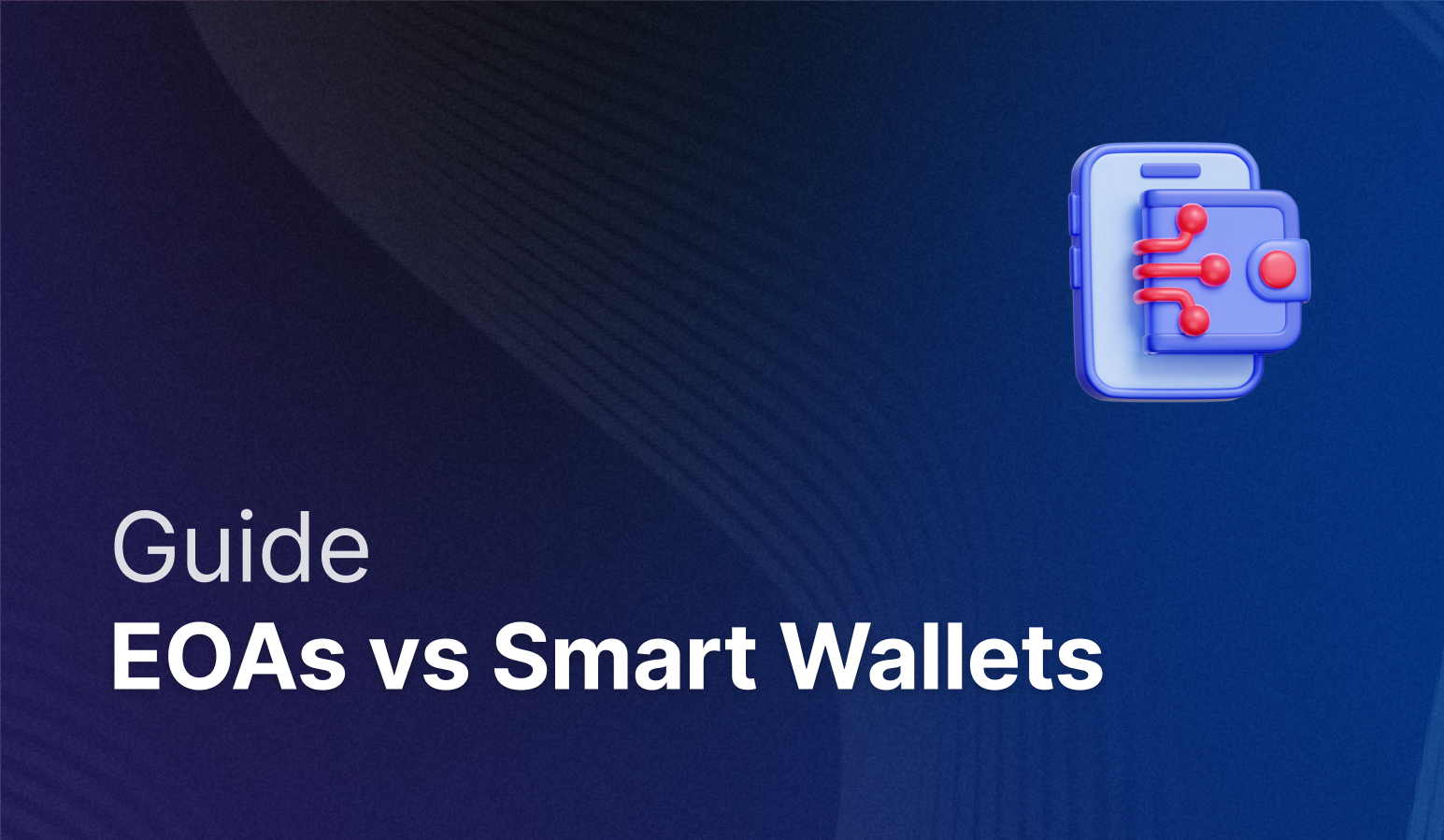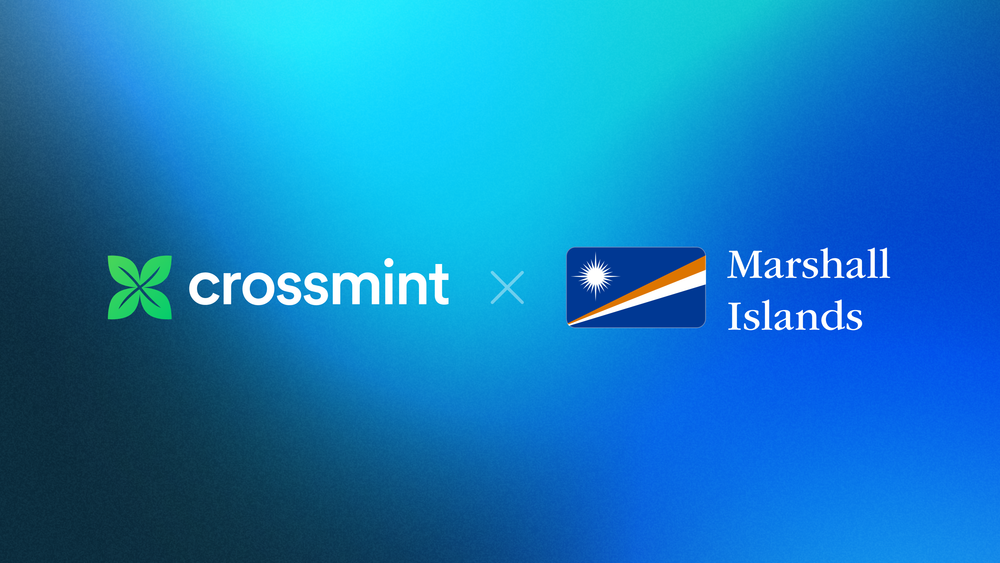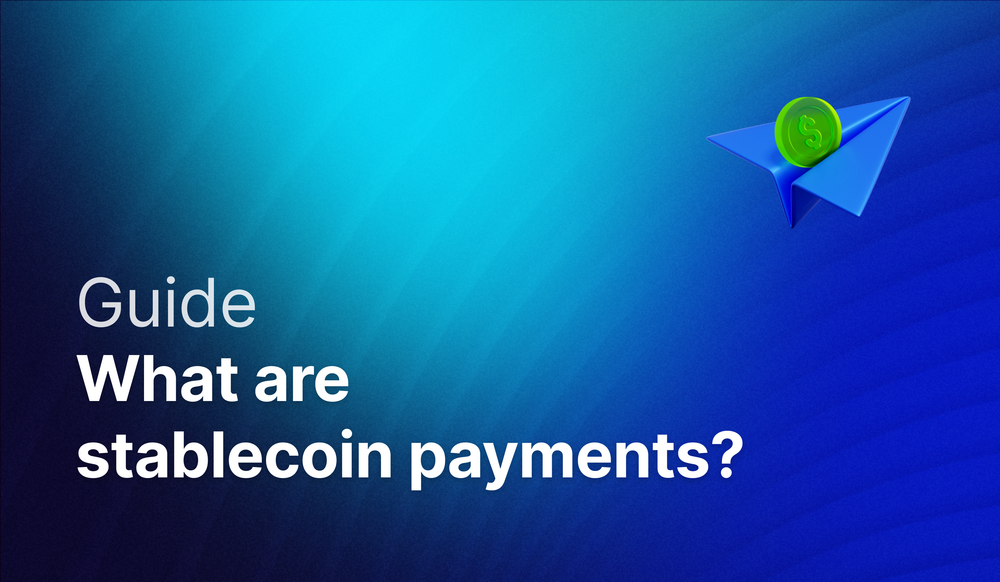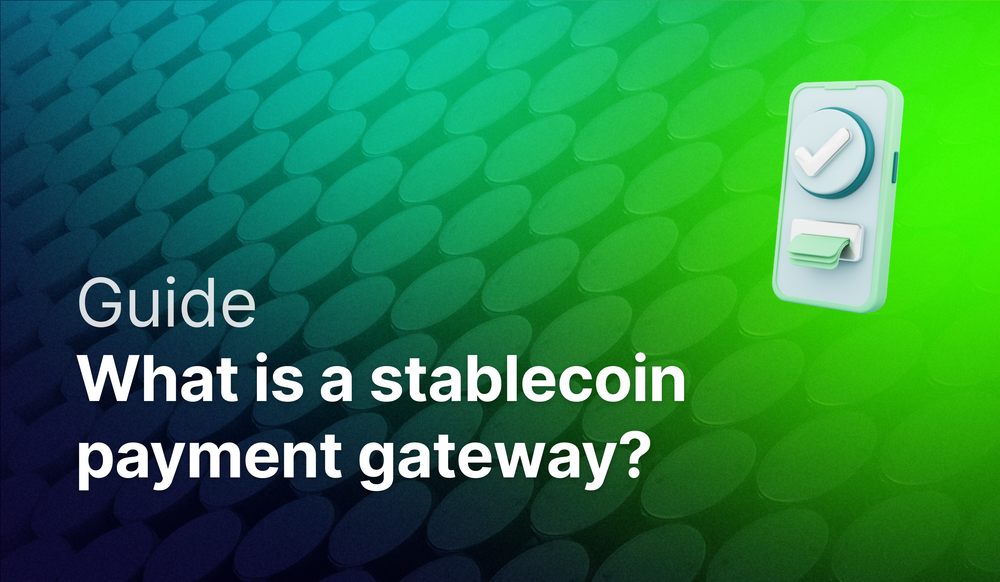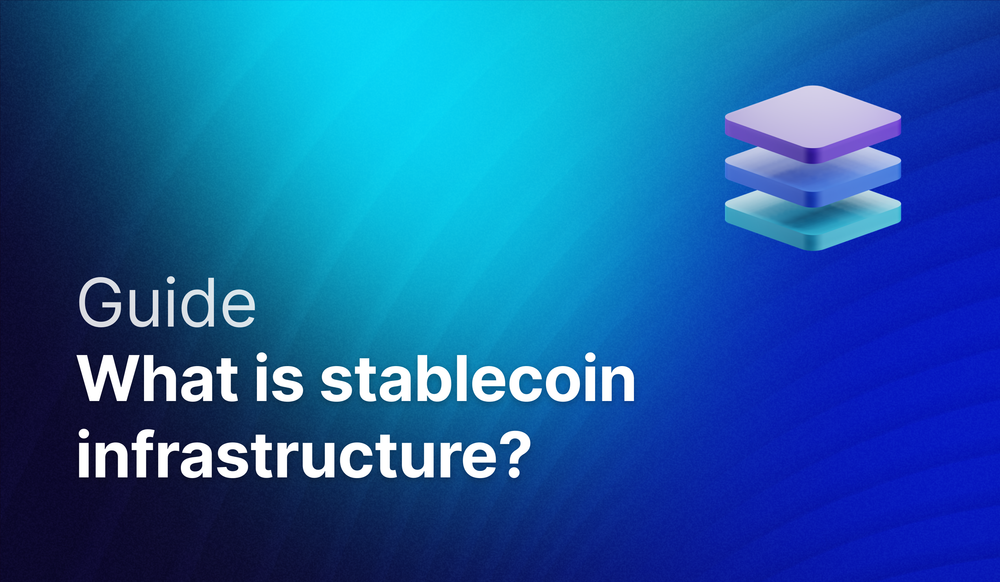If you're looking to build on stablecoin or crypto rails, you've likely encountered two different wallet architectures: Externally Owned Accounts (EOAs) and smart wallets. While both serve as accounts on blockchain networks, they work in fundamentally different ways and unlock different capabilities.
Understanding the difference matters because your wallet architecture determines what user experiences you can build and which features you can offer.
What is an externally owned account (EOA)?
An Externally Owned Account (EOA) is the original wallet type on Ethereum and most EVM chains. It's a simple account controlled by a private key.
Here's how EOAs work:
- A user generates a private key and corresponding public address
- The private key controls the account completely
- Every transaction requires a signature from that private key
- The user pays gas for every transaction
- There's no additional logic or programmability
EOAs are simple by design. They're lightweight, compatible with every application, and easy to understand. Think of them as basic bank accounts where you hold the only key.
Popular wallet applications like Phantom use EOA architecture by default.
What is a smart wallet?
A smart wallet (also called a smart contract wallet or account abstraction wallet) is an account implemented as a smart contract. Instead of being controlled directly by a private key, the wallet's logic lives on-chain as executable code.
This opens up capabilities that EOAs simply can't offer:
- Multiple keys can control a single wallet address
- You can define custom authorization rules and spending limits
- Gas payments can be sponsored by applications
- Transaction batching reduces costs and complexity
- Account recovery becomes possible without seed phrases
- Permission structures can be programmed directly into the wallet
- Signer rotation allows you to change controlling keys without changing the wallet address
Smart wallets implement standards like ERC-4337 on Ethereum or use programmable smart contract protocols on Solana.
What's the difference between custodial and non-custodial wallets?
Before diving into the advantages of each architecture, it's important to understand custody - a concept that applies to both EOAs and smart wallets.
Custody refers to who controls the private keys that secure a wallet. This distinction matters because it determines who can access and move funds, and it has significant regulatory implications.
Non-custodial wallets
With non-custodial wallets, users maintain complete control over their private keys. No third party can access, freeze, or move funds without the user's explicit permission.
Traditional EOAs from browser extensions like Phantom are non-custodial. The user generates and stores their own seed phrase. Smart wallets can also be non-custodial when users control the signing keys, even if multiple keys exist.
Non-custodial wallets give users maximum control but place the burden of key management entirely on them. Lose access to your keys and there's no customer support team that can help recover funds.
Custodial wallets
Custodial wallets mean a third party controls the private keys on behalf of users. They offer convenience and account recovery but require trusting the custodian. They also create regulatory requirements since the custodian has control over user funds.
Why custody matters for your architecture decision
For enterprises and platforms, the custody model you choose affects regulatory obligations. Custodial services typically require licenses like VASP registration or money transmitter licenses. Non-custodial infrastructure avoids these requirements since the platform never controls user funds.
Both EOAs and smart wallets can be implemented as custodial or non-custodial depending on your infrastructure setup. The key is understanding how your custody model interacts with your chosen wallet architecture to meet both technical and regulatory requirements.
What are the advantages of EOAs?
EOAs provide a solid foundation for stablecoin and crypto applications:
- Universal compatibility: EOAs work with every blockchain application and protocol without additional infrastructure
- Full user control: Users have complete ownership through their private keys with no intermediaries
- Proven track record: EOAs have been battle-tested since Ethereum's launch and remain the most widely understood wallet architecture
- Low cost: No smart contract deployment fees or additional transaction overhead
- Simplicity: Straightforward implementation that developers can integrate quickly
What are the advantages of smart wallets?
Smart wallets unlock capabilities that enable the next generation of stablecoin and crypto applications:
- Enhanced security: Multi-signature requirements and programmable permissions reduce risk
- Better UX: Gasless transactions, social recovery, and transaction batching create smoother experiences
- Programmability: Custom logic enables use cases impossible with EOAs like automated operations and spending limits
- Flexible custody: Support for multiple signers and role-based access controls
- Account recovery: Built-in mechanisms to restore access without compromising security
- Signer rotation: Change controlling keys when employees leave or keys are compromised without changing the wallet address or moving assets
- Future-proof: Built for account abstraction standards that are becoming industry expectations
Why do fintechs, enterprises and AI agents need smart wallets instead of EOAs?
Smart wallets have become particularly important for enterprise applications and AI agent platforms. Why?
Enterprises need custody solutions that go beyond a single private key. They require approval workflows, spending controls, and audit trails. Smart wallets provide these features at the protocol level rather than relying on off-chain systems.
Traditional EOAs force enterprises into a difficult choice: either accept the security risk of a single key controlling assets, or build complex off-chain systems to manage keys and permissions. Smart wallets solve this by encoding governance and security rules directly into the wallet contract.
Signer rotation solves a critical enterprise problem
When an employee with key access leaves your company, EOAs create a nightmare scenario. You must move all assets to a new wallet with a new address, update all your systems, and notify counterparties of the address change.
Smart wallets eliminate this problem entirely. The wallet address stays constant while you rotate the underlying signing keys. Remove the departing employee's key, add a new authorized signer, and continue operations without disruption. This capability alone makes smart wallets essential for any enterprise managing significant on-chain assets.
AI agents need autonomous operation with safety boundaries
AI agents need wallets that can act autonomously while maintaining security boundaries. With smart wallets, you can grant an agent permission to execute specific types of transactions up to certain limits, while the owner retains ultimate control through a separate key. This dual key architecture solves the custody problem for agent platforms without creating regulatory issues.
For AI agent platforms specifically, smart wallets enable:
- Non-custodial architecture where the platform never controls user funds
- Autonomous operations within defined parameters
- Regulatory compliance by maintaining clear ownership boundaries
- Emergency controls that allow owners to halt or withdraw from compromised agents
How do EOAs and smart wallets differ in terms of ownership and security?
Ownership structure
EOAs have one private key that controls everything. Lose that key and you lose access forever. Smart wallets can have multiple signers, role-based permissions, or even social recovery mechanisms where trusted contacts can help restore access.
Transaction requirements
With EOAs, users sign every transaction and pay gas fees each time. Smart wallets enable gasless transactions through sponsored gas, where applications cover costs. They also allow transaction batching, where multiple operations execute in a single on-chain interaction.
Programmability
EOAs have zero programmability. They can only sign and send transactions. Smart wallets can encode logic directly into the account. Want to set spending limits? Restrict which contracts the wallet can interact with? Require multi-signature approval for large transfers? Smart wallets make this possible.
Recovery options
Losing access to an EOA means losing everything. No recovery mechanism exists at the protocol level. Smart wallets can implement recovery modules, allowing designated guardians or backup methods to restore access without compromising security.
Should you use EOAs or smart wallets for your application?
"The question isn't which architecture is better - it's what you're building. If you need programmable permissions, native gas sponsorship, or autonomous transactions, smart wallets are table stakes,” - Rodri Fernández Touza (Cofounder @ Crossmint)
EOAs make sense when you need:
- Maximum compatibility across all dApps and chains
- Simple wallet implementation without custom logic
- Users who are already comfortable managing private keys
- Minimal infrastructure dependencies
Smart wallets make sense when you need:
- Better user experience through gasless transactions
- Enhanced security through multi-sig or custom permissions
- Account recovery mechanisms
- Programmable rules for automated operations
- Support for AI agents that need autonomous transaction capabilities
- Signer rotation for enterprise key management
What are embedded wallets and how do they relate to EOAs and smart wallets?
Embedded wallets represent a different dimension of wallet architecture that's orthogonal to the EOA vs smart wallet distinction. While EOAs and smart wallets describe what type of on-chain account you're using, embedded wallets describe where the wallet is managed and how users interact with it.
What makes a wallet "embedded"?
An embedded wallet is integrated directly into your application rather than existing as a separate browser extension or mobile app. The application handles key generation and management, and users access their wallet through your interface without ever leaving your product.
Critically, an embedded wallet can use either EOA or smart wallet architecture under the hood. The embedding is about the user interface and key management approach, not the on-chain account type. You could build an embedded wallet that creates EOAs for users, or one that deploys smart wallets - the choice depends on which capabilities you need.
Why embedded wallets matter for product builders
Embedded wallets remove the friction of traditional crypto onboarding. Users don't need to leave your app to install a separate wallet, write down seed phrases, or understand private keys. They simply sign in using familiar authentication methods:
- Social logins (Google, Apple, email)
- Passkey authentication using biometrics
- Email or SMS verification
- Account recovery methods managed by the application
This dramatically improves conversion rates. Instead of losing users at the "install a wallet" step, you can onboard users exactly as they expect from modern web applications.
Embedded wallets and custody considerations
Embedded wallets can be built as either custodial or non-custodial depending on the infrastructure architecture. Wallet infrastructure companies like Crossmint allow you create and manage both types so you can use stablecoin infra as a competitive advantage. Non-custodial embedded wallets generate keys that only the user can access, often using encryption tied to the user's authentication method or Trusted Execution Environments (TEEs) that keep keys isolated even from the infrastructure provider.
The combination of embedded wallet UX with smart wallet capabilities creates particularly powerful experiences. Users get familiar social login flows while your application gains programmable permissions, gas sponsorship, and advanced security features. This is why many modern fintech and enterprise applications choose embedded smart wallets as their default architecture.
Choosing your embedded wallet infrastructure
The tradeoff with embedded wallets is that you're relying on third-party infrastructure to handle key management securely. This makes your choice of infrastructure partner critical. Look for solutions that use Trusted Execution Environments (TEEs) to ensure that private keys remain isolated and inaccessible even to the infrastructure provider itself, maintaining non-custodial properties while delivering seamless user experiences.
Crossmint provides wallet infrastructure and stablecoin payments to leading companies like MoneyGram, Wirex and more. Reach out to us to learn more about how crypto rails can give your business a competitive advantage.




